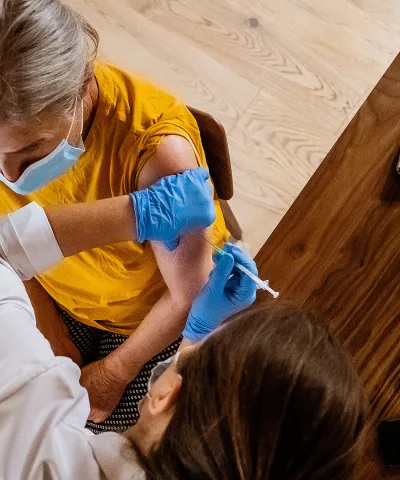Immunization is vital for the progress of global health and development. Our experts discuss the importance of immunization for preventive health and the emerging vaccine trends across the globe.
During the COVID-19 pandemic, we saw the severe consequences of not having adequate tools and resources to prevent the spread of an infectious disease. This has led to renewed awareness of the importance of preventive health. It has also generated a massive influx of both public and private funding for vaccine development and overall prevention to achieve better health.
Improving vaccine uptake for better preventive healthcare
We have seen a push for new vaccines to be added to national immunization programs (NIPs), with countries across the globe allocating significant resources toward preventive health and pandemic preparedness. For example, Japan is investing two billion US dollars toward its Strategic Center of Biomedical Advanced Vaccine Research and Development for Preparedness and Response (SCARDA) to ensure a quicker response to future pandemic threats. Similarly, Nigeria recently added the human papillomavirus (HPV) vaccine to its NIP and is planning a vaccination campaign to boost immunization rates.
These favorable changes have encouraged both established and emerging vaccine manufacturers to develop and commercialize vaccines for new diseases and populations.
However, this renewed interest is creating a more competitive environment for vaccines.
RSV (respiratory syncytial virus) vaccines are a prime example of this competition. There had been no advancements in RSV prevention since the late 1990s when Synagis (palivizumab) was approved. In 2023, the US and EU approved Sanofi’s Beyfortus, Pfizer’s Abrysvo, and GSK’s Arexvy, while several other manufacturers are also working on RSV vaccines. This level of competition is uncommon for vaccines, outside of influenza and COVID-19, and will create new commercialization challenges that vaccine manufacturers will need to overcome.
At Simon-Kucher, we believe in better health. Prioritizing disease prevention is critical, and the healthcare industry should continue to expand beyond treatment-centric approaches.
In particular, vaccines are fundamental to ensure improved health outcomes through disease prevention and avoidance of future infectious disease outbreaks. Vaccines can be highly cost-effective, since they offer low-cost solutions to prevent serious and expensive medical conditions. Our extensive experience with vaccines before and after the COVID-19 pandemic makes us an ideal advisory partner for both established and emerging vaccine companies navigating through this evolving vaccine environment.
National Immunization Technical Advisory Groups as critical gatekeepers
When preparing to launch a new vaccine, manufacturers must factor in the likelihood of different National Immunization Technical Advisory Group (NITAG) recommendation scenarios. Each country has a dedicated NITAG, responsible for recommending vaccine inclusion in the NIP based on multiple factors. This positions NITAGs as key stakeholders, since national pricing and reimbursement decisions are typically made based on, and sequential to, their value assessment and recommendation. These recommendations can severely limit the commercial opportunity of a product, which can even lead to manufacturers pulling their product off the market.
Historically, NITAGs have steered away from issuing preferential recommendations for individual vaccines without strong rationale. This hands-off approach allowed downstream stakeholders to make tailored decisions for patients without the risk of supply constraints. Achieving a preferential NITAG recommendation can, in theory, allow a manufacturer to capture almost the market share in relevant patient populations. However, willingness to issue a preferential vaccine recommendation and requirements for a preferential recommendation vary between markets and NITAGs.
New vaccines will need to differentiate themselves from established vaccines in individual markets through the following factors to qualify for a preferential NITAG recommendation:
- Increasing efficacy/effectiveness: Differences in clinical trial efficacy or real-world effectiveness between competing vaccines can lead to a preferential recommendation. For example, Canada’s National Advisory Committee on Immunization (NACI) initially recommended use of Pneumovax23 over Prevnar13 for immunization against pneumococcal disease in healthy adults aged 65 and older, because Prevnar13 lacked efficacy data on community-acquired pneumonia and IPD in this population at launch. Similarly, after decades of a non-preferential flu vaccine recommendation, Advisory Committee on Immunization Practices (ACIP) in the US now preferentially recommends Fluzone High-Dose, Fluad, or Flublok for adults aged 65 and older. This is driven by data supporting better effectiveness than standard dose unadjuvanted flu vaccines in this age group.
- Prioritizing safety: The preventive nature of vaccines means they are typically administered to healthy and at-risk individuals, unlike other types of treatments. As a result, prioritizing safety can lead to a preferential vaccine recommendation as NITAGs try to minimize harm to healthy individuals and to uphold public trust. Once multiple COVID-19 vaccines were available in the US, ACIP opted for mRNA vaccines over Janssen’s due to the higher risk of thrombosis with thrombocytopenia syndrome (TTS). Nevertheless, NITAG’s independent risk-benefit assessments often lead to inconsistent decisions between markets, as was seen with the varied timing and recommendation outcomes for different COVID-19 vaccines.
- Simplifying vaccination schedules: Combination vaccines offer an opportunity to streamline immunizations by replacing multiple individual vaccines. MMR and DTaP combination vaccines became the new standard for pediatric immunizations in many markets where their individual vaccine components were discontinued. In the UK, the MMR vaccine received a preferential recommendation, because the simplified schedule reduced the number of injections needed and improved vaccine coverage against measles, mumps, and rubella. We may see a similar shift toward dose reduction when combination respiratory vaccines come to market (e.g., ongoing development of vaccines combining flu, COVID-19, and RSV).
Beyond achieving a favorable recommendation, new vaccines launching into an increasingly crowded immunization landscape will need to be incorporated into the existing immunization schedule. Harmonization of vaccine schedules may become more of a focus for NITAGs to reduce the number of immunization-related visits for individuals and to avoid overburdening the healthcare system. For example, recent evidence suggests that RSV vaccines from GSK and Pfizer would likely be administered at least every two years (if not longer), whereas flu vaccines are recommended annually. However, inconsistent schedules between seasonal vaccines could result in reduced immunization rates. NITAGs will need to weigh the pros and cons of harmonizing vaccine schedules across vaccines or optimizing for each vaccine’s clinical benefit.
BETTER HEALTH: It will be critical for manufacturers to plan for and understand potential NITAG recommendation scenarios, as they will determine pricing, reimbursement, and the overall adoption of a new vaccine. Manufacturers launching a new vaccine must understand market-specific minimum requirements to avoid being disadvantaged by NITAGs and identify opportunities for a preferential recommendation. In case of a parity recommendation, manufacturers will need a robust brand strategy that identifies distinct growth opportunities for each vaccine.
Increasing economic pressure on vaccines
After the NITAG recommendation process, a vaccine generally undergoes a thorough economic assessment. Globally, vaccines are facing heightened economic pressure, as a consequence of extensive COVID-19 healthcare spending, expanding vaccine budgets (e.g., new vaccines), and broad macroeconomic pressure (e.g., inflation). This increased budgetary pressure may translate to reduced willingness to pay and downward price pressure at both an individual country and a global level (e.g., given risk of international price referencing).
Although tender markets face budget constraints and pricing pressure, differences in tender design create heterogeneity in manufacturers’ ability to use non-price levers. Price pressure is exacerbated in ‘winner takes all’ tenders as price is the key awarding criterion. Conversely, leveraging non-economic value drivers may be possible in markets where non-price factors are considered in awarding criteria, such as clinical evidence or the reliability of supply logistics for non-influenza vaccines in the UK.
As new technologies are developed and the vaccine space becomes increasingly crowded, manufacturers must prepare value-based arguments that effectively tie clinical differentiation to product price. For example, this is reflected in price and reimbursement decisions for high-dose and recombinant vaccines in influenza markets that were previously dominated by similarly priced standard-dose options. In particular:
- Purchasing decision-makers should be encouraged to consider value-based pricing, to support entry of advanced vaccines and enable efficient use of healthcare resources.
- More aggressive tender markets should be encouraged to accommodate increased flexibility in tender criteria (e.g., incorporate non-price related features into awarding criteria, allow multiple winners to guarantee supply across relevant populations).
BETTER HEALTH: With healthcare budgets facing increasing pressure globally, vaccine manufacturers will need to reinforce vaccine value communication to payers and purchasers, while shaping tender criteria to capture this value. Vaccine value proposition should go beyond standard clinical arguments and include economic arguments to avoid decisions based solely on net acquisition cost and budget. Such arguments should communicate savings associated with decreased hospitalizations, absenteeism, and broader direct and indirect healthcare costs.
Unlocking growth for vaccines in the US
The US is an important market for vaccine commercialization based on its share of global vaccine sales. However, recent pressures raised the barrier to entry for new vaccine manufacturers and have further exacerbated pricing competition. The perception that current vaccines adequately address medical needs creates barriers for new vaccines trying to capture incremental added value. For instance, even with an average effectiveness of around 42 percent, flu vaccines are widely regarded as sufficiently effective. Additionally, the consolidation of purchasing channels, including retail chains, grocery pharmacies, large Integrated Delivery Networks (IDNs), Group Purchasing Organizations (GPOs), and the shift of vaccinations from medical practice to large-volume retail settings have placed downward pricing pressure on vaccines.
To unlock value in the US, new vaccines should demonstrate that they address an unmet need for patients, providers, or other key stakeholders. Avoiding commoditization generally requires either a significant improvement over the standard of care, as GSK’s Shingrix did to unseat Merck’s Zostavax for prevention of herpes zoster/shingles, or being the first in an area previously unaddressed, like Valneva’s recent US approval of IXCHIQ for prevention of disease caused by chikungunya virus in adults.
Product differentiation can be further amplified through favorable ACIP recommendations, which can dictate a new vaccine’s success or failure by impacting payer access/reimbursement, purchasing, and utilization. In the case of Shingrix, significant improvement in efficacy and safety led to a preferential recommendation over Zostavax. This effectively removed Zostavax from the US market and catapulted Shingrix to $1 billion in US sales in the first two years of launch.
In addition to addressing unmet needs, vaccine manufacturers have to understand how to navigate the multi-channel US vaccine purchasing environment. Manufacturers should determine key purchasing channels for a given vaccine area before implementing channel-specific strategies that balance differing channel priorities and contracting needs. For example, more than half of adult influenza vaccines are administered in retail pharmacies, while the medical channel is more important for pediatric and maternal vaccines. To ensure commercial success of a vaccine, manufacturers must then tailor their contracting strategy to each purchasing channel’s existing vaccine offerings. For example, large purchasers, like national retail pharmacy chains and IDNs will likely leverage their substantial purchasing volume across a manufacturer’s portfolio for volume-based agreements with their preferred manufacturer.
BETTER HEALTH: It will be important for vaccine manufacturers to unlock further value for vaccines in the US through development of channel-specific strategies that address unmet needs of different customers. Successful commercialization of future innovative vaccines will be critical to deliver value to customers and, in turn, reduce long-term medical costs for the US healthcare system.
Trending Topic
Better Health
We help you to unlock better health for everyone. We see opportunity for the industry to deliver even more value by maintaining and improving health, going beyond just treating it.
With contributions from Madhurima Das, Ashlee Junier, Harry Carr, and Hayden Koerwer.




